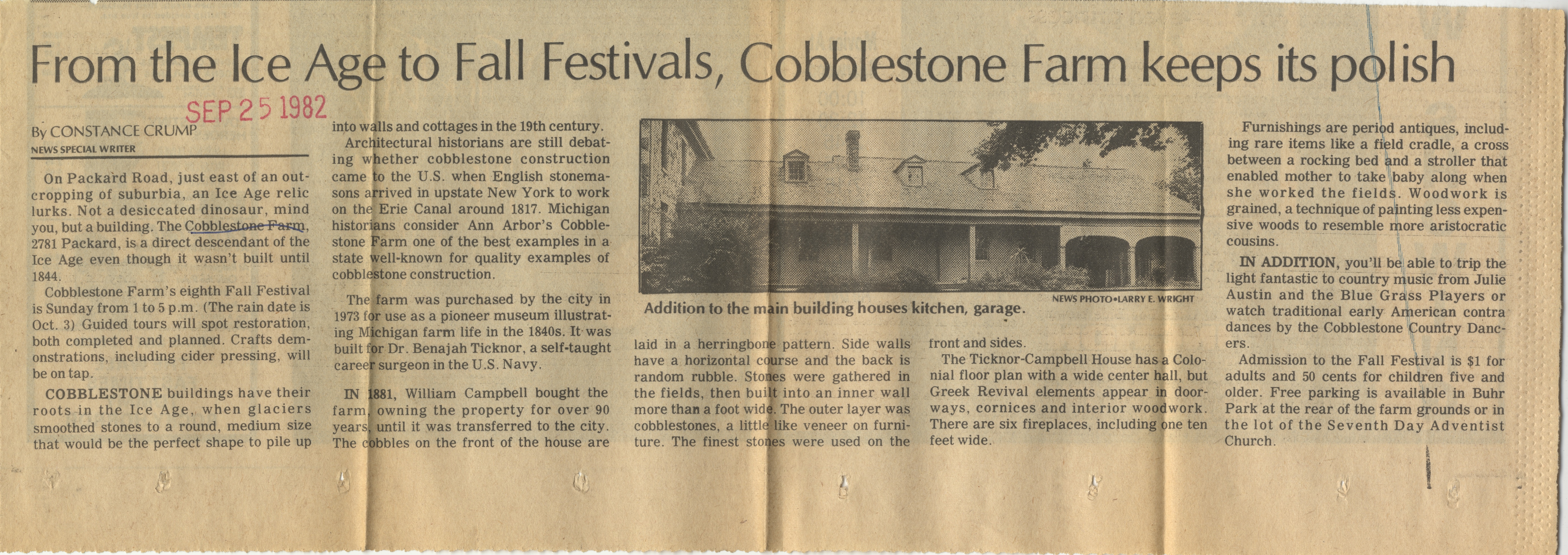From The Ice Age To Fall Festivals, Cobblestone Farm Keeps Its Polish

From the Ice Age to Fall Festivals, Cobblestone Farm keeps its polish
By CONSTANCE CRUMP
NEWS SPECIAL WRITER
On Packard Road, just east of an outcropping of suburbia, an Ice Age relic lurks. Not a desiccated dinosaur, mind you, but a building. The Cobblestone Farm, 2781 Packard, is a direct descendant of the Ice Age even though it wasn’t built until 1844.
Cobblestone Farm’s eighth Fall Festival is Sunday from 1 to 5 p.m. (The rain date is Oct. 3) Guided tours will spot restoration, both completed and planned. Crafts demonstrations, including cider pressing, will be on tap.
COBBLESTONE buildings have their roots in the Ice Age, when glaciers smoothed stones to a round, medium size that would be the perfect shape to pile up into walls and cottages in the 19th century.
Architectural historians are still debating whether cobblestone construction came to the U.S. when English stonemasons arrived in upstate New York to work on the Erie Canal around 1817. Michigan historians consider Ann Arbor’s Cobblestone Farm one of the best examples in a state well-known for quality examples of cobblestone construction.
The-farm was purchased by the city in 1973 for use as a pioneer museum illustrating Michigan farm life in the 1840s. It was built for Dr. Benajah Ticknor, a self-taught career surgeon in the U.S. Navy.
IN 1881, William Campbell bought the farm, owning the property for over 90 years, until it was transferred to the city. The cobbles on the front of the house are laid in a herringbone pattern. Side walls have a horizontal course and the back is random rubble. Stones were gathered in the fields, then built into an inner wall more than a foot wide. The outer layer was cobblestones, a little like veneer on furniture. The finest stones were used on the front and sides.
The Ticknor-Campbell House has a Colonial floor plan with a wide center hall, but Greek Revival elements appear in doorways, cornices and interior woodwork. There are six fireplaces, including one ten feet wide.
Furnishings are period antiques, including rare items like a field cradle, a cross between a rocking bed and a stroller that enabled mother to take baby along when she worked the fields. Woodwork is grained, a technique of painting less expensive woods to resemble more aristocratic cousins.
IN ADDITION, you’ll be able to trip the light fantastic to country music from Julie Austin and the Blue Grass Players or watch traditional early American contra dances by the Cobblestone Country Dancers.
Admission to the Fall Festival is $1 for adults and 50 cents for children five and older. Free parking is available in Buhr Park at the rear of the farm grounds or in the lot of the Seventh Day Adventist Church.
Addition to the main building houses kitchen, garage.
Article
Subjects
Constance Crump
Benajah Ticknor Farm
Buhr Park
Building Restoration
Centennial Farms
Cobblestone Country Dancers
Cobblestone Farm
Cobblestone Farm Association
Fall Festival
Farms & Farming
Historic Buildings
Julie Austin & the Blue Grass Players
Museums
National Register of Historic Buildings & Places
Seventh Day Adventist Church
Ticknor-Campbell House
Has Photo
Old News
Ann Arbor News
Benajah Ticknor
William Campbell
Larry E. Wright
2781 Packard Rd